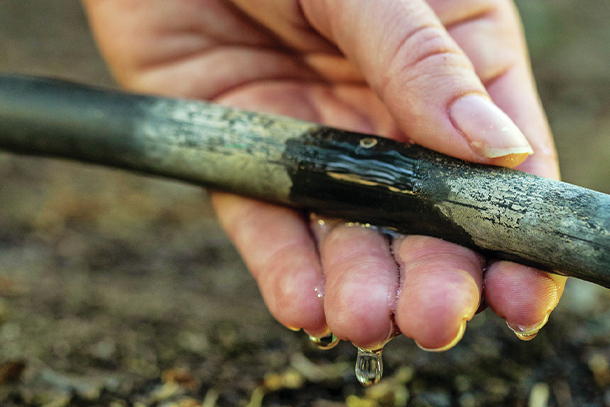Considering the water issues the industry faced this year, it’s imperative for growers to do the simple things that will ensure their irrigation system is operating efficiently. Tom Devol, ABC senior manager of field outreach, said while harvest is wrapping up, now is the time to flush irrigation lines and submains, and check your riser t-screens for clogging. “Putting your irrigation system to bed clean will greatly benefit growers next season,” he said.
Aside from this basic maintenance, better understanding your irrigation options and learning small ways to improve your practices has never been easier, thanks to the Almond Board of California’s (ABC’s) new Pathway to Irrigation Improvement guide.
The guide – which can be downloaded or printed from ABC’s website – aims to help growers track their progress in implementing irrigation best practices, and is something growers can keep in their truck or office and to reference regularly. It is divided into four sections: Irrigation Systems, Water Use, Monitoring Soil and Plant Water Status, and Management. Each section has specific practices associated with it that are rated as Levels 1.0 (fundamental), 2.0 (intermediate) and 3.0 (advanced).
For instance, under Irrigation Systems, a grower at level 1.0 would regularly record the pressure variation in his or her system and calculate an average application rate while irrigating. A 2.0 grower would employ more sophisticated practices – such as measuring distribution uniformity – to achieve “more crop per drop” of water, and then a 3.0 grower would be even more advanced as he or she would look to employ those efficient practices more regularly.
Tom Devol, ABC’s senior manager of Field Outreach and Education, noted that all the information in the guide is culled from the 149-page Almond Irrigation Improvement Continuum, created by the Almond Board and the University of California’s Agriculture and Natural Resources team.
“For this guide, we took the incredibly detailed Irrigation Continuum and restructured it with simplified visual cues,” Devol explained. “This way, when growers approach the Continuum and want to refer to specific sections that will help them reach the next level of efficiency, they can reference this guide to quickly understand where in the Continuum they should look.
How to achieve ‘more crop per drop’
To be most efficient in optimizing your irrigation practices, Devol said the first step for any grower is to “know how your irrigation system uses water and evaluate how well your system performs.”
Next, growers need to focus on understanding water use.
“How much do your trees need?” Devol asked. “We walk you through three levels to determine that. Then you need to determine second part, which is to understand how much water you’re using.”
From there, growers are encouraged to gain a stronger grasp of their soil moisture and then learn how to best manage it, which especially helps growers in times when the trees may be experiencing more stress.
The final element of optimal practices is the execution of learnings and best practices so growers can best set themselves up for success.
“When you know what you’re doing, you will know how to manage it,” Devol said. “You have to first know your need, how much water your system is putting out and how to measure it, and then you’ll determine how to manage it.”
Devol and his team work closely with growers up and down the state on irrigation practices. They use the feedback they receive face-to-face as well as information provided by growers who participate in the California Almond Sustainability Program (CASP) to determine the focus of their outreach.
“For instance, from information pulled in aggregate from the CASP database, I can see where California almond growers (as a whole) are excelling and where an increase in improved practices could be achieved – where I have more work to do,” Devol said.
As an example, Devol said that about 75% of growers still use visual means to determine tree stress instead of using a pressure chamber, which can provide a more accurate analysis of stem water potential (how much water moves through a leaf).
“That tells me I need to do more training,” he said, adding that grower understanding of soil physics and plant stress are two of the most challenging and complicated areas with which he deals.
Recognizing that pressure chambers are expensive tools – costing as much as $4,000 each – Devol and his team have developed what he calls a “lending library.” Growers can “check out” a pressure chamber for a couple of weeks and use it in their orchard before making a commitment to buy one. Growers interested in “checking out” a pressure chamber should email fieldoutreach@almondboard.com for more information.
Ultimately, the purpose behind this guide and the larger Irrigation Continuum is to give growers useful information they can act on and provide support along their growing journey, striving to help the industry as a whole achieve the Almond Orchard 2025 Goals, one of which is to reduce water use by an additional1 20%.
“We have a really diverse grower population,” Devol explained. “With some practices, it’s hard to get to Level 3.0, and some practices simply don’t work well for certain growers’ orchard systems. We’re therefore just trying meet everyone where they’re at and help them make improvements to ultimately help them ensure a more healthy, productive orchard.”
1 Why “additional”? Over the past two decades, almond growers have successfully reduced the amount of water needed to grow a pound of almonds by 33% via improved production practices and adoption of efficient microirrigation technology. (Source: University of California, 2010. Food and Agriculture Organization of the United Nations, 2012. Almond Board of California, 1990-94, 2000-14.


